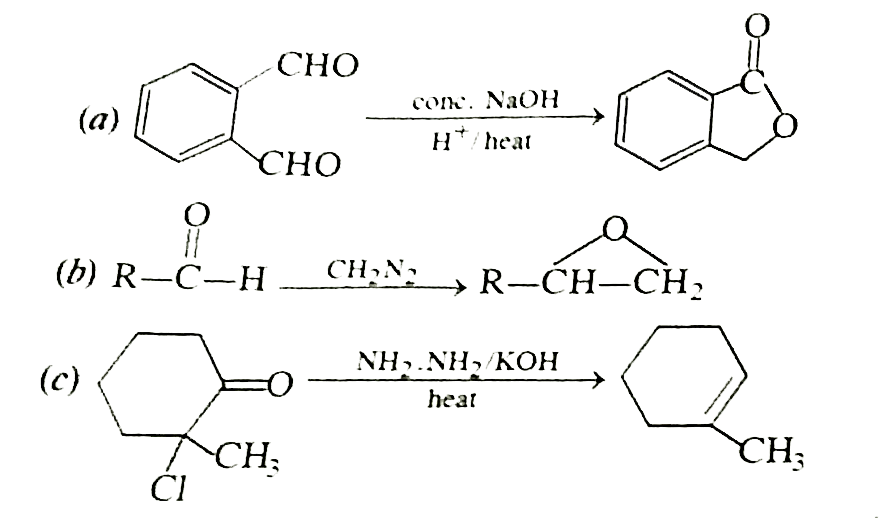How will you bring about the following conversions in not more than two steps?
Benzaldehyde to 1-phenylpropan-1-ol
To convert benzaldehyde to 1-phenylpropan-1-ol in not more than two steps, we can follow these steps:
Step 1: Formation of the Grignard Reagent
1. Prepare the Grignard Reagent: Start by preparing a Grignard reagent from an alkyl halide. In this case, we will use ethyl bromide (C2H5Br) to form the Grignard reagent, ethyl magnesium bromide (C2H5MgBr). The reaction is as follows:
C2H5Br+Mg→C2H5MgBr
This reaction occurs in dry ether.
Step 2: Nucleophilic Addition to Benzaldehyde
2. React the Grignard Reagent with Benzaldehyde: Next, we will react the Grignard reagent (C2H5MgBr) with benzaldehyde (C6H5CHO). The nucleophilic carbon of the Grignard reagent will attack the electrophilic carbon of the carbonyl group in benzaldehyde:
C6H5CHO+C2H5MgBr→C6H5CH(OH)C2H5+MgBrOH
After this reaction, we will have an intermediate alcohol (1-phenylpropan-1-ol) which will be formed.
Step 3: Hydrolysis
3. Hydrolyze the Intermediate: The final step involves hydrolyzing the intermediate formed in the previous step to yield the desired product, 1-phenylpropan-1-ol. This can be done by adding water or an acid (like HCl) to the reaction mixture:
C6H5CH(OH)C2H5+H2O→C6H5CH(OH)C2H5
This gives us the final product, 1-phenylpropan-1-ol.
Final Product
The final product of this conversion is 1-phenylpropan-1-ol (C6H5CHOHCH2CH3).
---
1. Prepare the Grignard Reagent: Start by preparing a Grignard reagent from an alkyl halide. In this case, we will use ethyl bromide (C2H5Br) to form the Grignard reagent, ethyl magnesium bromide (C2H5MgBr). The reaction is as follows:
C2H5Br+Mg→C2H5MgBr
This reaction occurs in dry ether.
2. React the Grignard Reagent with Benzaldehyde: Next, we will react the Grignard reagent (C2H5MgBr) with benzaldehyde (C6H5CHO). The nucleophilic carbon of the Grignard reagent will attack the electrophilic carbon of the carbonyl group in benzaldehyde:
C6H5CHO+C2H5MgBr→C6H5CH(OH)C2H5+MgBrOH
After this reaction, we will have an intermediate alcohol (1-phenylpropan-1-ol) which will be formed.
3. Hydrolyze the Intermediate: The final step involves hydrolyzing the intermediate formed in the previous step to yield the desired product, 1-phenylpropan-1-ol. This can be done by adding water or an acid (like HCl) to the reaction mixture:
C6H5CH(OH)C2H5+H2O→C6H5CH(OH)C2H5
This gives us the final product, 1-phenylpropan-1-ol.
The final product of this conversion is 1-phenylpropan-1-ol (C6H5CHOHCH2CH3).
Topper's Solved these Questions
- ALDEHYDES, KETONES AND CARBOXYLIC ACIDSBOOK - ICSECHAPTER - ALDEHYDES, KETONES AND CARBOXYLIC ACIDSEXERCISE - ISC EXAMINATION QUESTIONS (PART-II DESCRIPTIVE QUESTIONS) (CARBOXYLIC ACIDS)
99 Videos
- ALCOHOLS, PHENOLS AND ETHERS BOOK - ICSECHAPTER - ALCOHOLS, PHENOLS AND ETHERS EXERCISE - ISC EXAMINATION QUESTIONS
25 Videos
- APPENDIX II ( TYPICAL CONVERSIONS)BOOK - ICSECHAPTER - APPENDIX II ( TYPICAL CONVERSIONS)EXERCISE - AROMATIC CONVERSIONS
98 Videos
Similar Questions
How will you bring out the following conversion?

View SolutionHow will you bring about the following conversions in not more than two steps?
Benzaldehyde to benzophenone
View SolutionHow will you bring about the following conversions in not more than two steps?
Benzaldehyde to benzophenone
View SolutionHow will you bring about the following conversions in not more than two steps?
Benzaldehyde to benzophenone
View SolutionHow will you bring about the following conversions in not more than two steps ?
Toluene to Benzaldehyde
View SolutionHow will you bring about the following changes :

View SolutionHow will you bring about the following conversions in not more than two steps?
Bromobenzene to 1-phenylethanol
View SolutionHow will you bring about the following conversions in not more than two steps?
Bromobenzene to 1-phenylethanol
View SolutionHow will you bring about the following conversions in not more than two steps?
Bromobenzene to 1-phenylethanol
View SolutionHow will you bring about the following conversions in not more than two steps?
Benzaldehyde to α-hydroxyphenylacetic acid
View Solution
